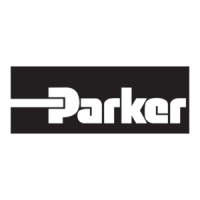Parker Hannifin S.p.A. Divisione S.B.C. user’s manual TWIN-N and SPD-N
18
1.6 Main software features
The following functions have been implemented in the basic software:
Speed controller
Advanced manager of torque limits
Management of speed windows
Torque motor control
Torque control with speed control overlaying
Positioning with trapezoidal Speed profiles
Provides the functions of an electrical shaft with variable ratio and phase correction
Electronic cam
Simulates a stepper motor
It is provided with an internal PLC for programming inputs/outputs
Serial interface RS422-485 integrated: TWIN-N has two independent nodes
Can bus interface: TWIN-N has two independent nodes.
1.7 Expansibility: the Parker-SBC Bridge and its philosophy
Manufacturing companies of machines that use “servo” motor drives frequently have the need of
combining the PLC with the axis control.
The two programmable components are often heterogeneous; the first one sees to the machine logics
management, whereas the second one sees top the motor motion profile management. The skills
required to manage the two products are so different that they require different persons, with a
consequent increase of costs and new problems to manage, that is, the interface between two non-
homogeneous worlds.
Besides having all of the features required by the market of a servo converter, the Parker-S.B.C.
drives for brushless motors are also capable of executing “motion” functions that can be used for a
large number of applications, without having the typical need of programming an axis control. Their
feature is that they can operate as “MOTION ENGINE”, that is, with a component that commands
the motor to execute the desired motion profile, while the MACHINE LOGICS is still managed by
the PLC or by the machine PC.

